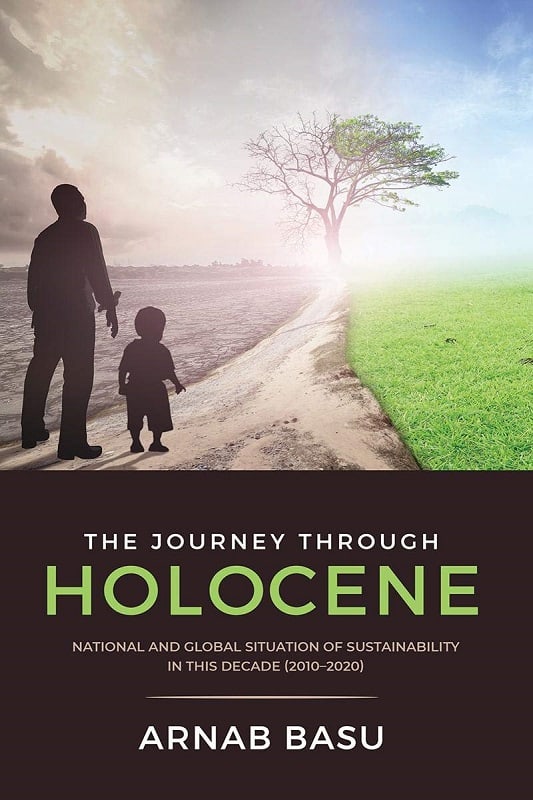SUBJECT: 3.5/5
RELEVANCE: 4/5
WRITING STYLE: 3.5/5
RESEARCH: 4/5
FINAL VERDICT: 3.5/5
“Scientists say that earth has gone through five mass extinction so far- the first one in 450-440 million years ago to the latest one 66 million years ago- due to volcanism, low oxygen content in the atmosphere, glaciation, flood basalt events or asteroid impacts. Whatever the reasons were behind all previous mass extinction, those all were natural extinction. But the sixth mass extinction which would mark the end of Holocene is going to be anthropogenic or human-induced natural extinction, as predicted by the scientific community. “
– Arnab Basu, The journey through Holocene
About the book
The Journey through Holocene is a collection of articles on issues related to the sustainability of this pale blue planet which we call our home. The articles mainly focus on how India as a nation is dealing with climate change-related challenges, ecological imbalance, and sustainable development in the decade, 2010-2020. The author of this book believes that the 6th mass extinction, the end of the Holocene is inevitable. The first five chapters explain how the time period between 2the 010-2020 has contributed to this journey through Holocene. Before we talk about the end of the Holocene and how that’s going to happen let us first understand what does the term “Holocene” means? Holocene is name the given to the last 11,700 years of earth’s history the time since the end of the ice age.
About the author
Arnab Basu is an environmentalist by passion and profession. He has had nearly two decades of experience in the field of environment and sustainability consultancy and five years of association as natural history commentator with natural history, non-profit, NGO, Exploring Nature. His writing on the environment and natural history started in 2015. He has written many articles, editorials, and short stories but “The journey through Holocene” is his first book.
What to expect?
Expect a book that talks in detail about the environment, ecosystem, sustainability, and various human activities that are slowly deteriorating the planet.
Who can read?
Anyone interested in learning about our environment, sustainability, and the future of planet earth.
Writing Style
“The journey through Holocene” is a book that talks in detail about the collapse of the ecosystem and the need to conserve it before it gets too late. The book is written in a format that feels like you are reading a textbook on the environment and ecology. There are reports, data, facts, figures, and abbreviations that are interesting but also intimidating at times. The approach to read this book should be different from reading fiction, only then the reader would be able to enjoy the book.
Even though the blurb says that this book is for everybody concerned about sustainability, I won’t recommend this book to beginner-level readers. There were some editing mistakes but they were few
and far between.
What did I like?
• I liked the in-depth discussion on biodiversity, wildlife, and the author’s take on topics such as ecotourism and its impact on the flora and fauna. The author raises valid questions on human gluttony and how it is degrading the quality of life on earth.
• It was an informative read.
• The cover of the book does a great job in illustrating the content of the book. On one side there is clear blue sky and lush greenery and on the other side clouds of dust and barren fields. One glance at the cover and the reader would understand what’s the message of the book.
• The paper quality was awesome. I know what matters more is what’s written on the pages but I have to mention that the print and paper quality of this book is excellent.
What could have been better?
- The concept was interesting, the message was loud and clear however the execution left the reader confused at times. There was too much data to remember, so if you are a beginner and you are thinking about reading this book, don’t try to read it in one go. Break down the book into several sections or just read one chapter at a time.
- It gets repetitive sometimes.
- There should be a glossary for all the technical terms.
- The book mainly focuses on the problem and its consequences. The challenge of ecological imbalance and degrading ecosystems is enormous and I understand that until and unless the government starts taking proper steps it cannot be resolved. But It would have been great if the author has included steps that can be taken on an individual level to prevent the deterioration of nature.
In the end
The ever-increasing global population, urbanization, and consumerism are changing the face of the earth and the future of our next generations. Mother nature is reminding us that this is the high time we shift our perspective to sustainable development and find a way to restore the degraded ecosystem.
Pick this book :
• If you are interested in learning about nature and wildlife.
• You like books with extravagant vocabulary.
• You are an avid reader of non-fiction or newspaper editorials.
• You like reading books about nature.
Skip the book:
• If you are looking for a book which can be read in a single sitting.
• If you hate textbooks ( You are not alone )
• If you never liked reading Geography or environmental studies in school.
Can’t wait to read it? Buy your copy of “The Journey through Holocene” using the link below
